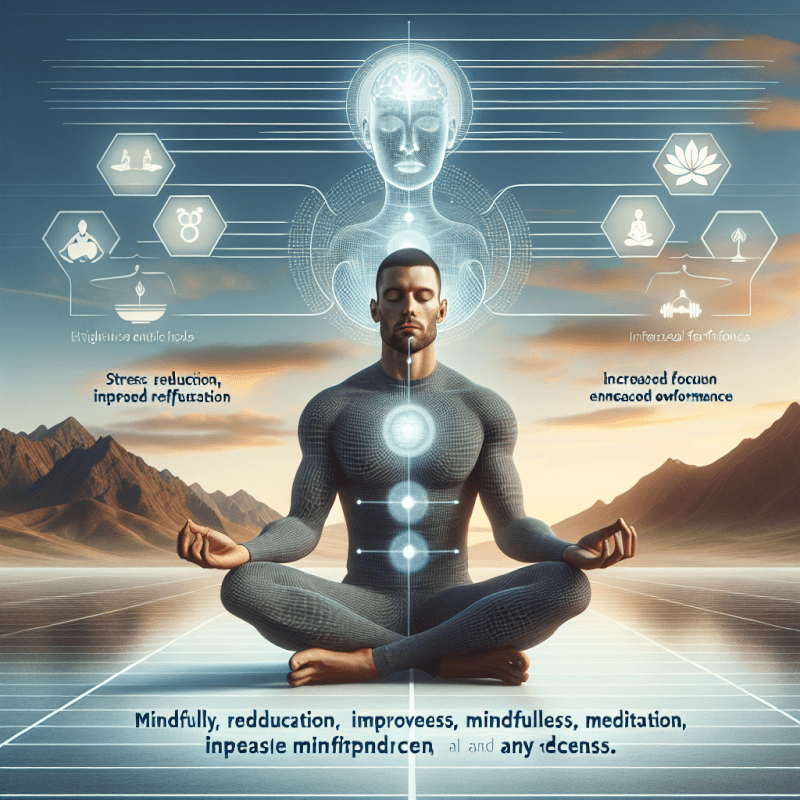Are you looking to enhance your fitness routine and achieve a more holistic approach to your well-being? Incorporating mindfulness and meditation into your daily exercise regimen could be the key to unlocking a whole new level of physical and mental benefits. By focusing on the present moment and cultivating a sense of calm, mindfulness and meditation can help you become more in tune with your body, improve your workout performance, reduce stress levels, and enhance your overall fitness journey. Discover how these practices can work synergistically with your fitness routine to create a balanced and fulfilling lifestyle.
Benefits of Mindfulness and Meditation
Reduced Stress and Anxiety
Incorporating mindfulness and meditation into your fitness routine can greatly reduce stress and anxiety. When you practice mindfulness, you learn to focus your attention on the present moment, allowing you to let go of worries and concerns about the past or future. This can help alleviate stress and anxiety that may arise from daily life or strenuous workouts. By cultivating a state of calm and presence through meditation, you can experience a greater sense of peace and relaxation.
Improved Focus and Concentration
Mindfulness and meditation have been shown to enhance focus and concentration, which can be incredibly beneficial during workouts. When you train your mind to remain present and focused, you can better tune into your body’s sensations and signals during exercise. This heightened awareness can help you maintain proper form, improve technique, and optimize your movements. By sharpening your focus through mindfulness and meditation, you’ll be able to make the most out of your fitness routine.
Increased Self-Awareness and Body Awareness
Practicing mindfulness and meditation can heighten your self-awareness and body awareness, allowing you to better understand your physical and mental states. By regularly checking in with yourself through mindfulness practices such as body scan meditation, you can develop a deeper connection with your body. This increased awareness can help you identify areas of tension or discomfort and make adjustments to your workout or recovery routine accordingly. By cultivating self-awareness and body awareness, you can fine-tune your fitness practices for optimal results.
Enhanced Emotional Well-being
Mindfulness and meditation can have a profound impact on your emotional well-being. These practices can help you cultivate a positive outlook, reduce negative emotions, and manage stress more effectively. By incorporating mindfulness into your fitness routine, you can approach your workouts with a sense of calm and positivity. Meditation techniques like loving-kindness meditation can also foster compassion and empathy towards yourself and others, enhancing your overall emotional well-being. By nurturing your emotional health through mindfulness and meditation, you’ll find greater joy and satisfaction in your fitness journey.
Improved Physical Performance
Better Mind-Muscle Connection
Mindfulness and meditation can improve your mind-muscle connection, allowing you to optimize your physical performance during workouts. By bringing awareness to each movement and muscle group, you can ensure proper engagement and activation. This increased connection between your mind and muscles can help you perform exercises with more precision and efficiency, leading to better results and reduced risk of injury.
Increased Energy Levels
Regular mindfulness and meditation practices can boost your energy levels, providing you with the vitality and stamina needed for an effective fitness routine. When you practice mindfulness, you’re better able to manage your energy by recognizing when you need rest or when you can push yourself further. Meditation techniques like focused attention meditation can also help you cultivate a state of alertness and wakefulness, enhancing your overall energy and vitality.
Improved Endurance and Stamina
Mindfulness and meditation can contribute to improved endurance and stamina, allowing you to sustain longer and more challenging workouts. By training your mind to stay present and focused, you can overcome mental barriers and push through physical fatigue. The ability to stay mentally strong and resilient can greatly impact your endurance and stamina, helping you achieve new levels of performance in your fitness routine.
Enhanced Recovery
Incorporating mindfulness and meditation into your recovery routine can significantly enhance your body’s ability to rest and heal. By practicing mindfulness during your post-workout routine, you can promote relaxation and reduce muscle tension. This, in turn, supports the recovery process and helps prevent injuries. Additionally, meditation techniques like body scan meditation can help you identify areas of soreness or discomfort, allowing you to target specific muscle groups for recovery and self-care.

Mindfulness Practices
Breathing Exercises
One of the fundamental mindfulness practices is conscious breathing. By paying attention to your breath and focusing on the sensation of inhaling and exhaling, you can bring your attention back to the present moment and cultivate a state of relaxation. Deep, diaphragmatic breathing can help regulate your heart rate and activate the relaxation response, making it an excellent tool for managing stress and anxiety both during and outside of your fitness routine.
Body Scan Meditation
Body scan meditation involves systematically focusing your attention on each part of your body, from head to toe, and noticing any physical sensations or areas of tension. This practice promotes body awareness and can help you identify areas that may need attention or relaxation. By incorporating body scan meditation into your fitness routine, you can enhance your understanding of your body’s needs and respond accordingly, preventing injuries and optimizing recovery.
Walking Meditation
Walking meditation is a form of mindfulness practice that involves walking at a slow and deliberate pace while maintaining a focused awareness on each step and the sensation of movement. This practice can be a great addition to your fitness routine, especially on rest or recovery days. By practicing walking meditation, you can engage in low-impact movement while still reaping the benefits of mindfulness and self-awareness.
Guided Imagery
Guided imagery involves using the power of your imagination to create vivid mental images that promote relaxation and positive emotions. Incorporating guided imagery into your fitness routine can help you visualize successful workouts, optimal performance, and overall well-being. By immersing yourself in positive mental imagery, you can cultivate a mindset of confidence and motivation, enhancing your overall fitness experience.
Meditation Techniques
Focused Attention Meditation
Focused attention meditation involves directing and sustaining your attention on a specific object or focus point, such as your breath, a mantra, or a visual image. By continually redirecting your attention back to the chosen object whenever your mind wanders, you cultivate a greater ability to sustain focus and concentration. This technique can help you stay present and engaged during your workouts, promoting optimal performance and reducing distractions.
Loving-Kindness Meditation
Loving-kindness meditation involves cultivating feelings of love, compassion, and kindness towards oneself and others. By silently repeating positive phrases or well-wishes during meditation, you activate feelings of warmth and kindness within yourself. Incorporating loving-kindness meditation into your fitness routine can help foster self-compassion, reduce self-criticism, and enhance your overall well-being. This technique can be particularly beneficial during challenging workouts or times when you need to nurture your body and mind.
Transcendental Meditation
Transcendental meditation is a technique that involves silently repeating a mantra, a specific word or phrase, to help quiet the mind and enter a state of deep relaxation and inner stillness. This technique can be highly effective for reducing stress and promoting a sense of peace and clarity. By practicing transcendental meditation regularly, you can enhance your ability to manage stress, improve focus, and experience a greater sense of calm during your fitness routine.
Mindfulness-Based Stress Reduction (MBSR)
Mindfulness-Based Stress Reduction (MBSR) is a well-known program that combines mindfulness meditation and yoga to help individuals manage stress and enhance well-being. This evidence-based program can be a valuable resource for incorporating mindfulness into your fitness routine. MBSR involves various meditation techniques, gentle movement exercises, and discussions to guide you in developing mindfulness skills for stress reduction and self-care.

Incorporating Mindfulness and Meditation into Fitness
Pre-Workout Routine
Before starting your workout, take a few moments to center yourself and bring mindfulness into your practice. Begin by practicing a breathing exercise to calm your mind and prepare your body for the upcoming physical activity. You can use techniques such as diaphragmatic breathing or alternate nostril breathing to promote relaxation and focus. This pre-workout mindfulness practice can help you transition from the busyness of your day to a more present and intentional state.
During Your Workout
During your workout, maintain mindful awareness of your body, breath, and sensations. Focus on the present moment and tune into the physical sensations associated with each movement and exercise. By staying present and engaged, you can optimize your form, technique, and effort. Incorporate occasional moments of stillness or deliberate pauses to check in with your body and assess any discomfort or tension. Listen to your body’s signals and make adjustments as needed to prevent injuries and optimize your workout experience.
Post-Workout Routine
After your workout, take time to engage in a post-workout mindfulness practice to support your recovery and aid muscle relaxation. This can involve incorporating a body scan meditation to identify areas of tension or soreness and intentionally releasing any resistance or tightness. Consider practicing a guided imagery meditation to envision your body healing and recovering, fostering a positive mindset towards recovery. By concluding your workout with mindfulness, you can bring a sense of peace and gratitude to your body and its efforts.
Recovery and Rest Days
On recovery and rest days, prioritize mindfulness and meditation to support your body’s healing and rejuvenation. Engage in longer meditation sessions, incorporating various techniques such as focused attention meditation or loving-kindness meditation. This extended practice can help calm the mind, reduce stress, and promote deep relaxation. Consider integrating gentle movement practices like yoga or walking meditation to provide gentle, restorative movement while still cultivating mindfulness.
Mindful Eating and Nutrition
Paying Attention to Food Choices and Portion Sizes
Mindful eating involves paying full attention to the experience of eating, including the taste, smell, texture, and satisfaction derived from food. By practicing mindful eating, you can become more aware of your food choices and make healthier, balanced decisions that support your fitness goals. Mindful eating also involves listening to your body’s hunger and fullness cues, allowing you to eat in a way that honors your body’s unique needs and prevents overeating.
Eating with Awareness and Gratitude
Incorporate mindfulness into your meals by approaching them with awareness and gratitude. Take a few moments before eating to express gratitude for the nourishment and sustenance provided by your food. As you eat, savor each bite and chew slowly, fully experiencing the flavors and textures. By bringing mindfulness to your meals, you can cultivate a sense of appreciation and enjoyment for the nourishing experience of eating.
Listening to Hunger and Fullness Cues
Developing a greater awareness of your body’s hunger and fullness cues is essential for maintaining a healthy relationship with food and optimizing your nutrition. Mindfulness practices can help you tune into these signals and eat intuitively, honoring both your physical and emotional needs. By listening to your body’s cues and eating mindfully, you can make choices that support your fitness goals and overall well-being.
Reducing Emotional Eating
Mindful eating can also help you break free from emotional eating patterns. By cultivating awareness of your emotional states and how they influence your eating habits, you can develop healthier coping strategies and create a more balanced relationship with food. Incorporating mindfulness into your approach to eating can help you recognize emotional triggers and respond to them in ways that are nourishing and supportive, rather than relying on food for comfort.

Creating a Mindful Environment
Designating a Calm and Peaceful Space
Creating a designated space for mindfulness and meditation can contribute to a more relaxing and focused practice. Choose a quiet area in your home or outdoors where you feel comfortable and can minimize distractions. Decorate the space with calming elements such as candles, soft lighting, or nature-inspired artwork. By immersing yourself in a serene environment, you can enhance your ability to cultivate a state of mindfulness and relaxation.
Minimizing Distractions and External Stimuli
To fully immerse yourself in your mindfulness and meditation practice, it’s important to minimize distractions and external stimuli that may divert your attention. Turn off electronic devices or put them on silent mode to limit interruptions. Choose a time of day when you’re less likely to be disturbed, or communicate with others in your household to respect your practice time. By creating a quiet and undisturbed environment, you can fully engage in your mindfulness and meditation practices.
Playing Relaxing Music or Nature Sounds
The power of sound can greatly enhance your mindfulness and meditation experiences. Consider playing relaxing music or nature sounds during your practice to create a soothing and calming atmosphere. Choose instrumental tracks, nature sounds, or guided meditations that resonate with you and support your state of relaxation and focus. By incorporating calming sounds into your practice, you can deepen your sense of tranquility and facilitate a more profound experience of mindfulness.
Using Aromatherapy or Incense
Aromatherapy can be a valuable tool for creating a mindful environment and enhancing your meditation practice. Invest in essential oils or incense with scents known for their calming and grounding properties, such as lavender, chamomile, or sandalwood. Use a diffuser or burn incense before or during your mindfulness and meditation practices to fill the space with the soothing aroma. The combination of scent and mindfulness can deepen your relaxation and promote a greater sense of presence.
Mindfulness Apps and Resources
Headspace
Headspace is a popular mindfulness app that offers a wide range of guided meditation and mindfulness practices. It provides structured programs for different goals, including stress reduction, better sleep, and increased focus. With its user-friendly interface and diverse range of meditation options, Headspace can be a helpful resource for incorporating mindfulness into your fitness routine.
Calm
Calm is another well-known mindfulness app that offers a variety of guided meditations, sleep stories, and relaxation techniques. It features a library of meditative music and nature sounds to help create a calming atmosphere. Calm’s meditation programs are designed to support stress reduction, mindfulness, and inner peace, making it a valuable tool for integrating mindfulness into your fitness journey.
Insight Timer
Insight Timer is a meditation app that provides a vast library of guided meditations, music tracks, and talks from renowned meditation teachers. It offers a range of meditation durations and styles, allowing you to customize your practice based on your needs and preferences. Insight Timer also provides a community aspect, allowing you to connect with other meditators and join groups or challenges for added motivation.
The Mindfulness App
The Mindfulness App is a comprehensive meditation app that offers guided meditations, courses, and reminders to support your mindfulness practice. It features a timer with customizable settings, allowing you to adjust meditation durations and intervals according to your preferences. The Mindfulness App also provides daily mindfulness reminders and tracks your progress, helping you stay consistent and committed to your practice.

Combining Mindfulness, Meditation, and Exercise
Yoga and Pilates
Yoga and Pilates are physical practices that naturally incorporate mindfulness. Both disciplines emphasize breath awareness, body-mind connection, and present moment awareness. By integrating yoga or Pilates into your fitness routine, you can further enhance your mindfulness practice. These practices not only build strength and flexibility but also cultivate mental focus and self-awareness, making them an ideal complement to mindfulness and meditation.
Tai Chi and Qigong
Tai Chi and Qigong are ancient Chinese practices that combine slow, flowing movements with deep breathing and meditation. These practices promote balance, coordination, and relaxation while cultivating a state of mindfulness. By incorporating Tai Chi or Qigong into your fitness routine, you can experience the benefits of mindful movement, improved body awareness, and enhanced mental clarity.
Mindful Running and Walking
Running and walking can be transformed into mindful practices by bringing awareness to your body, breath, and surroundings. Rather than letting your mind wander or getting caught up in distractions, focus on each step, the rhythm of your breathing, and the sensations in your body. By staying present and engaged in the present moment, you can elevate your running or walking routine into a meditative experience that nurtures both your body and mind.
Martial Arts
Martial arts disciplines such as karate, taekwondo, or kung fu provide an excellent opportunity to merge mindfulness with physical movement. These practices require focus, discipline, and the ability to remain present. By immersing yourself fully in the techniques and forms, you can develop greater body awareness, heightened concentration, and enhanced self-control. Martial arts not only improve physical fitness but also foster mental fortitude and mindfulness.
Overcoming Challenges
Consistency and Commitment
One of the main challenges when incorporating mindfulness and meditation into your fitness routine is maintaining consistency and commitment. It’s important to establish a regular practice by setting aside dedicated time each day or week for mindfulness activities. Start with smaller, achievable goals and gradually increase the duration or frequency of your practice. Consider using reminders or integrating mindfulness into your existing routines, such as practicing mindfulness while brushing your teeth or during your morning commute.
Dealing with Impatience and Frustration
Impatience and frustration may arise when you first begin practicing mindfulness and meditation. It’s normal for the mind to wander and for thoughts to arise during meditation sessions. Instead of judging yourself or getting frustrated, cultivate an attitude of compassion and non-judgment. Accept that distractions are part of the practice and gently bring your attention back to the present moment. Over time, patience and persistence will help you develop greater focus and resilience.
Finding the Right Balance
Finding the right balance between pushing yourself in your fitness routine and honoring your body’s needs can be challenging. Mindfulness can help you navigate this balance by allowing you to listen to your body and respect its limitations. Be attuned to physical and mental fatigue, pain, or signs of overexertion. By practicing mindfulness, you can make adjustments to your exercise intensity, duration, or type according to your body’s feedback. Strive for a balanced approach that supports both challenge and self-care.
Seeking Professional Guidance
If you’re new to mindfulness and meditation, seeking professional guidance can be beneficial. Consider working with a mindfulness coach, meditation teacher, or joining a structured program like Mindfulness-Based Stress Reduction (MBSR). These resources can provide valuable guidance, support, and personalized instruction to help you integrate mindfulness into your fitness routine. A professional can help address any challenges you may encounter and tailor the practices to your individual needs and goals.
In conclusion, incorporating mindfulness and meditation into your fitness routine offers numerous benefits for both your physical and mental well-being. By reducing stress and anxiety, improving focus and concentration, increasing self-awareness and body awareness, and enhancing emotional well-being, mindfulness and meditation can significantly enhance your overall fitness experience. By exploring various mindfulness practices and meditation techniques, incorporating them into different aspects of your fitness routine, practicing mindful eating, creating a mindful environment, and utilizing mindfulness apps and resources, you can optimize the integration of mindfulness and meditation into your fitness journey. Overcoming challenges, such as consistency and commitment, impatience and frustration, finding the right balance, and seeking professional guidance when needed, will further support your growth and development in these practices. Embrace the opportunity to combine mindfulness, meditation, and exercise, and enjoy the holistic benefits they offer in achieving a balanced and fulfilling fitness routine.



